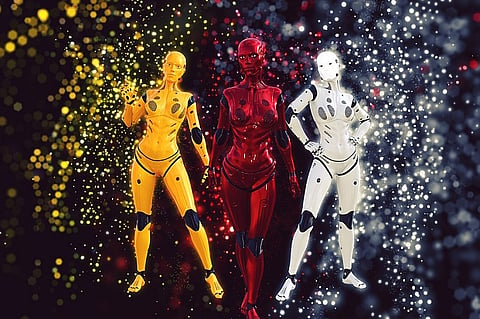

Vivek Kumar
On April 25, 2018, Elon Musk got the Twitterati baffled with his stark revelation. ‘Oh btw I’m building a cyborg dragon,” he tweeted. Yes, the brain behind Tesla Motors and SpaceX is now onto his next groundbreaking project, a cyborg dragon.
While the Twitter post mentions nothing explicitly about the cyborg dragon, it shouldn’t be taken lightly, because Elon Musk is the one making that statement. It may or may not be a fire-breathing dragon, but it’ll be a head turner for sure. The connotation of ‘cyborg’ denotes that Musk’s creation will have an ‘organic' touch to it.
Before we talk about the concept of Cyborgs, it’s important to take a moment and appreciate the revelations that have been brought forth purely because of the widespread adaptation of Artificial Intelligence and Machine Learning. If you find yourself struggling with the underlying concepts of these and want to do something about it, we recommend you go through AI and ML courses that’ll help you get going.
Now, let’s talk more about Cyborgs!
The Concept of Cyborgs
The human fascination with hybrids - part man and part machine - dates back to centuries ago. This insatiable thirst for creating such a being gave rise to the concept of the ‘Cyborg.’ The term was first coined in 1960, by Manfred Clynes and Nathan Kline, when they co-authored a paper for a space exploration NASA conference.
According to the duo, a cyborg is a combination of ‘cybernetics’ and ‘organism’. However, it does not merely mean that the cyborg is a simple amalgamation of organic and synthetic components. To Clynes and Kline, it represented a unique “approach to tackle the technical challenges of space travel—physically adapting man to survive a hostile environment, rather than modifying the environment alone.”
Soon after, in 1963, “The Cyborg Study” was published. The purpose of the study was to assess “the theoretical possibility of incorporating artificial organs, drugs, and/or hypothermia as integral parts of the life support systems in spacecraft design of the future, and of reducing metabolic demands and the attendant life support requirements.”
By separating the ‘robot-like’ functions of a man from the aspects that make him ‘human,’ Clynes and Kline depicted a cyborg as a realization of a concrete transhumanist goal - a human free from the constraints of his inherent mechanical (robot-like) limitations as well as the conditions that surround him, all through mechanization.
Today, the term ‘cyborg’ has transcended the domain of space exploration to evolve into an “expansive mesh of the mythological, metaphorical and technical.” Chris Hables Gray, who has written a lot on cyborgs, states that ‘cyborg’ has now become “as specific, as general, as powerful, and as useless a term as tool or machine.”
Cyborg Intelligence: Recent advances
Cyborg intelligence revolves around the idea that biological beings and computers share certain common physical foundations. For instance, the nervous system in organic beings and computers communicate with other parts of the systems through electrical signals. Cyborg intelligence seeks to create an intricate connection between artificial intelligence and biological intelligence. BMIs are the ideal way to bridge the gap between organic and machine components.
Brain-machine interfaces (BMIs) can be used to connect computer systems and biological systems This allows the perceptive abilities of the biological system to seamlessly combine with the cognitive skills of the computer system, to compensate for the weaknesses of both systems. This will, eventually, give rise to something strong and powerful.
Here are some recent research areas in the field of cyborg intelligence:
Animals as sensors - utilizing the highly advanced sensors of animals, such as the olfactory sense of dogs.
Animals as actuators - using animals as actuators to accomplish particular functions.
Mind-controlled machines - decoding and unlayering the human mind to control external machines successfully.
Neurochips - designing chips that can connect to neuronal cells. For instance, memory chips that can efficiently replace the memory cortex for enhancing and restoring memory.
Intelligent prosthesis - developing devices that can replace a missing or damaged body part through brain interfacing. Such devices will help enhance precision and facilitate easy movements.
Neuromorphic - create analog, digital, and mixed-mode analog/digital VLSI and software systems that can mimic neural network functions like perception and motor control.
Symbiotic cognition - combining biological, cognitive functions with computational cognitive models.
Advantages of Cyborg Intelligence
Cyborg intelligence holds immense promise for the treatment of diseases like cerebral palsy and Parkinson’s disease. It can prolong life by improving the quality of life.
An intelligent prosthesis can be a boon for differently-abled people. It can endow on them the ability to move and perform functions like everyone else. The sensory inputs powered by cyborg intelligence will allow us to communicate better.
Cyborg intelligence essentially depends on the co-adaptation and co-learning between organic and machine components. It can help us answer many vital yet unanswered questions relating to AI. By doing so, it can change the AI landscape in a significant way. And it is up to us to decide the extent and depth of integrating human and technology to give rise to innovations that can change lives for the better.
All views expressed are personal. Vivek is the President of Consumer Revenue at UpGrad, an online education platform providing industry oriented programs in collaboration with world-class institutes. He has been leading businesses & multi-cultural teams with a consistent record of market-beating performance and building brand leadership.